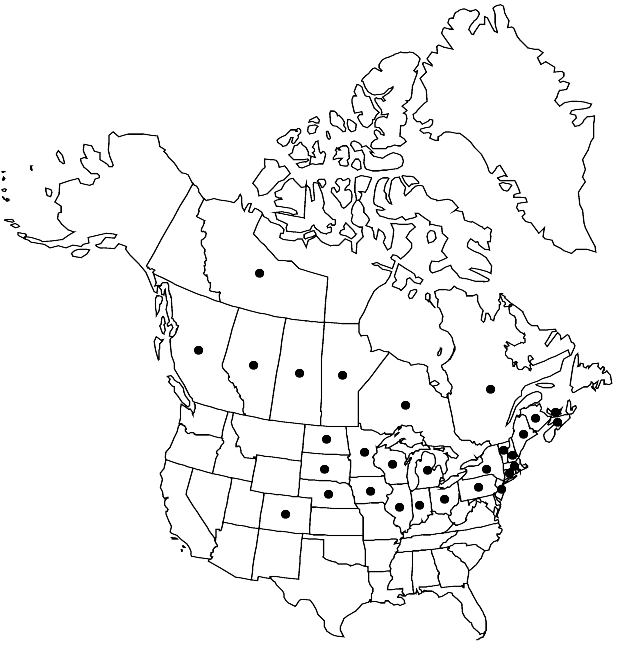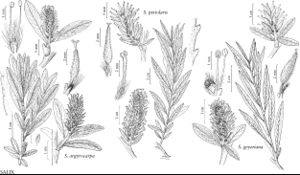Salix petiolaris
Trans. Linn. Soc. 6: 122. 1802.
Plants 1–6 m. Stems: branches red-brown or violet, not or weakly glaucous, (dull or slightly glossy), puberulent; branchlets yellow-green to red-brown, sparsely pubescent or moderately densely velvety, (buds alba-type or intermediate). Leaves: stipules rudimentary or absent; petiole shallowly grooved adaxially, 3–11 mm, pubescent, or velvety to glabrescent adaxially; largest medial blade lorate or very narrowly elliptic, 38–110 × 6–19 mm, 5–9 times as long as wide, base cuneate or convex, margins flat to slightly revolute, entire, serrate, serrulate, or spinulose-serrate, apex acute to acuminate, abaxial surface glaucous, densely long-silky to glabrescent, hairs (white, sometimes also ferruginous), adaxial dull or slightly glossy, glabrous or sparsely pubescent, (hairs white, sometimes also ferruginous); proximal blade margins sometimes serrulate; juvenile blade moderately densely long-silky abaxially, hairs white, sometimes also ferruginous. Catkins flowering as leaves emerge; staminate stout to globose, 12–29 × 6–17 mm, flowering branchlet 0.8–3 mm; pistillate loosely flowered, stout to globose, 12–39 × 6–18 mm, flowering branchlet 1–11 mm; floral bract brown, tawny, light rose, or bicolor, 1–2 mm, apex rounded, abaxially sparsely hairy, hairs straight. Staminate flowers: adaxial nectary square, ovate, or oblong, 0.3–0.7 mm; filaments distinct, hairy basally; anthers purple turning yellow, ellipsoid or globose, 0.4–0.6 mm. Pistillate flowers: adaxial nectary oblong to ovate, 0.3–0.9 mm; stipe 1.5–4 mm; ovary pyriform, beak abruptly tapering to styles; ovules 6–12 per ovary; styles 0–0.5 mm; stigmas slenderly to broadly cylindrical, 0.26–0.4–0.8 mm. Capsules 5–9 mm. 2n = 38.
Phenology: Flowering mid Apr-mid Jun.
Habitat: Sedge meadows, openings in moist, low, rich deciduous woods, sandy or peaty wet prairies, lakeshores
Elevation: 10-2700 m
Distribution

Alta., B.C., Man., N.B., N.W.T., N.S., Ont., P.E.I., Que., Sask., Colo., Conn., Ill., Ind., Iowa, Maine, Mass., Mich., Minn., Nebr., N.H., N.J., N.Y., N.Dak., Ohio, Pa., S.Dak., Vt., Wis.
Discussion
See 107. Salix sericea for a comparative description.
Because reproductive barriers between Salix petiolaris and S. eriocephala are weak, A. Mosseler (1990) suggested that their morphological variability may be due to interspecific gene flow.
Hybrids:
Salix petiolaris forms natural hybrids with S. bebbiana, S. candida, S. eriocephala, S. famelica, S. pellita, and S. sericea. Hybrids with S. alba have been reported (M. L. Fernald 1950) but no convincing specimens have been seen. Controlled pollinations with S. discolor produced no seed (A. Mosseler 1990).
Reports of Salix petiolaris × S. sericea from Massachusetts and Pennsylvania (C. K. Schneider 1921) probably refer to the densely sericeous variant of S. petiolaris. It is sometimes named S. ×subsericea (Andersson) C. K. Schneider but does not seem to be a hybrid (G. W. Argus 1965, 1986; E. G. Voss 1972–1996, vol. 2).
Selected References
None.
